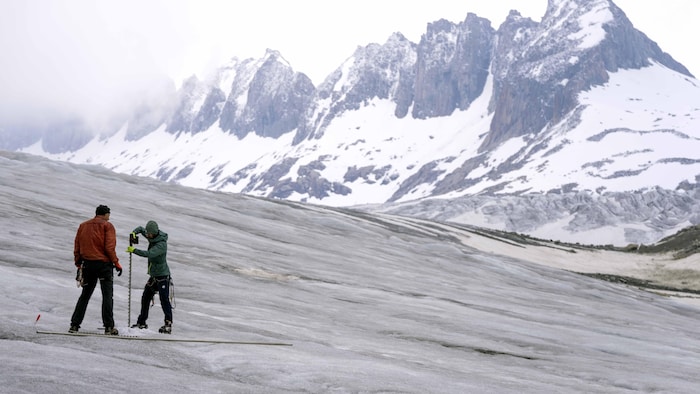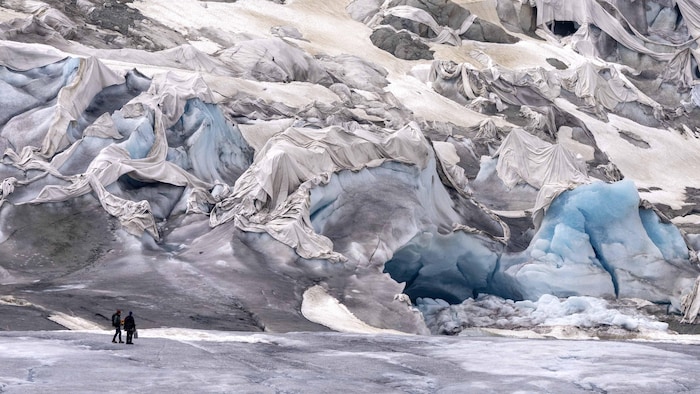Climate changes seem to transform certain Swiss glaciers into Swiss cheese: lots of holes.
Matthias Huss, member of the glacier surveillance group GLAMOSgave an overview of the Rhône glacier, which feeds the eponymous river crossing Switzerland and France to throw itself into the Mediterranean.
He shared his observations with theAssociated Press this month, while he was hiking on the icy extent for a first maintenance mission
summer aimed at monitoring your state of health.

It is in Switzerland that we find the greatest number of glaciers among European countries.
Photo : AP / Matthias Schrader
The state of Swiss glaciers was highlighted in a striking and dramatic way in the eyes of the international community last month, when a mud flow from an Alpine mountain overwhelmed the village of Blatten, in the southwest of the country. The glacier Birchlocated on the mountain, which held a rocky mass near the summit, gave in, causing an avalanche in the village below.
According to experts, geological changes and, to a lesser extent, global warming played a role in this event.
Fortunately, the village had been largely evacuated beforehand, but the Swiss authorities reported that a 64 -year -old man was disappeared after the incident. Tuesday evening, the Valais regional police announced that they had found and examined the remains of a person who died in the mud flow.
The Alps and Switzerland, which house the largest number of glaciers from all European countries, have seen them retreat for about 170 years, but with ups and downs over time until the 1980s, said Mr. Huss. Since then, the decline has been constant, the years 2022 and 2023 being the worst of all. Last year was a little better
he said.
This year does not look good either, so we see a clear acceleration of the tendency to the melting of glaciers
warned Mr. Huss, who is also a lecturer at the Federal Polytechnic School of Zurich (Ethz), under a radiant sun and with melted snow that flows under his feet.
Less snow and more heat create difficult conditions
The European Union Copernicus Copernicus Center said that last month was the second month of the hottest May ever recorded worldwide, although temperatures in Europe were lower than the current average for this month compared to the average from 1991 to 2020.
Europe is not the only one concerned. In a climate report in Asia published on Monday, the United Nations World Meteorological Organization warned that the reduction of snowfall in winter and the extreme summer heat of last year were painful for glaciers
23 of the 24 glaciers of the central Himalayas and the chain of the Tian Shan having undergone a loss of mass
In 2024.
A healthy glacier is considered to be dynamic
because it generates new ice when the snow falls on it at high altitude, while melting at low altitude: the mass losses at low altitude are compensated by the high altitude gains.
But as global warming increases the melting to higher altitudes, these flows will slow down, even stop completely, and the glacier will essentially become A plaque of ice that simply stays there
explained Mr. Huss.

The Rhône glacier is covered with canvases to try to delay its cast iron.
Photo : AP / Matthias Schrader
This is a situation that we observe more and more often on our glaciers: the ice is simply no longer dynamic, he said. She just stays there and melts on site.
Appearance of holes
This lack of dynamic regeneration is the most likely process at the origin of the appearance and persistence of the holes, apparently caused by the turbulence of water at the bottom of the glacier or by the air flows that cross the interstices that appear inside the ice blocks, analyzed Mr. Huss.
The holes appear first in the middle, then they grow more and more, and suddenly, the roof of these holes begins to collapse, he explained. These holes then become visible from the surface. They were little known a few years ago, but we now see them more often.
A glacier thus affected, he added, is like a Swiss cheese that covers more and more holes, and these holes collapse, which is not good for the glacier
.
Fishing and border effects
Richard Alley, professor of geosciences and glaciologist at university Penn Statestressed that the decline in glaciers has significant repercussions on agriculture, fishing, drinking water levels and border tensions when it comes to cross -border rivers.
The greatest concerns about mountain glaciers may be the problems related to water. Currently, declining glaciers fuel rivers in summer [souvent la saison sèche] With abnormally high flows compared to normal, but this will be replaced by abnormally low flows as the glaciers disappear
he said in an email.
For Switzerland, electricity could also be affected: this Alpine country draws the vast majority of its energy from hydroelectric power plants fed by its lakes and its rivers, and the large -scale melting of glaciers could compromise this supply.
5 to 10 centimeters per day
In a roar of helicoid forest, Mr. Huss steals ice creams by piercing a hole in the glacier. Then, with the help of an assistant, he unfolds an articulated metallic pole, similar to the basic technology used for decades to monitor the glaciers, and the start -up to drive it deeply. This serves as a gauge to measure the depth of the glacier.
We have a network of stakes sunk into the ice that allow us to determine the melting and mass loss of the glacier from one year to the next, he explained. When the glacier melts, at a current pace of about 5 to 10 centimeters per day, this stake will reappear.

Mathias Huss uses graduated metal rods to measure the melting of Swiss glaciers.
Photo : AP / Matthias Schrader
Raising his arms above his head, about 2.5 meters, he shows the height of a stake that was pressed in September, suggesting that the mass of ice has decreased more. During 2022, particularly hot, almost 10 meters of vertical ice were lost in one year, he said.
Some glaciers have disappeared forever
The planet already reaches the maximum limit of 1.5 degrees Celsius of the increase in global temperature fixed in the Paris climate agreement of 2015. The concerns linked to global warming which led to this agreement were recently overshadowed by commercial wars, conflicts in Ukraine and the Middle East and other geopolitical questions.
Even if we manage to reduce or limit global warming to 1.5 degrees, we will not be able to save this glacier
warned Mr. Huss, recognizing that many Swiss glaciers are called upon to disappear in the future. As a person, Mr. Huss is moved. As a glaciologist, he is impressed by the speed of change.
It is always difficult for me to see these glaciers melt, or even disappear completely. Some of the sites I have been watching for 20 years have completely disappeared in recent years
he said.
It’s very sad – when we see this beautiful brilliant whiteness replaced by these friable rocks that litter the ground.
But on the other hand, he added, it is also a very interesting period for a scientist, who can witness these very fast changes.

